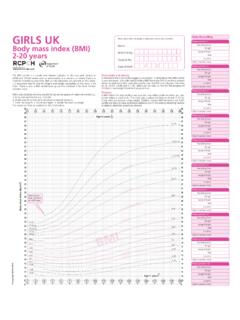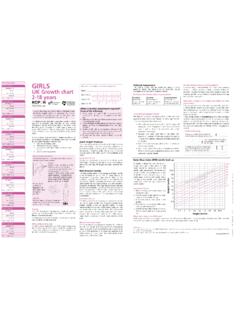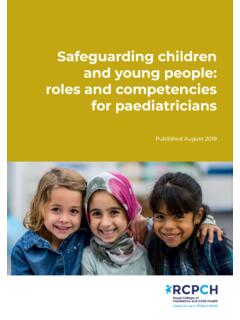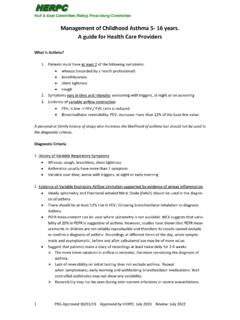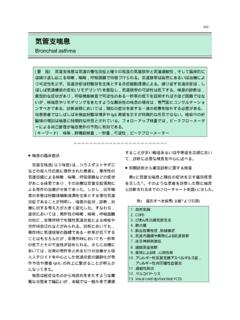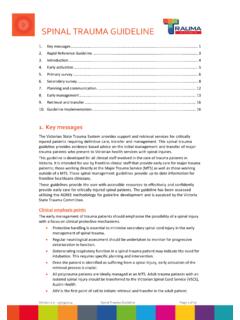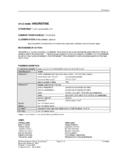Transcription of Allergy Care Pathways for Children Anaphylaxis
1 Page 1 -v1 This document can be downloaded at: Royal College of Paediatrics and Child Health 2011 Using the care pathwayThe Royal College of Paediatrics and Child Health (RCPCH) care pathway for Anaphylaxis is presented in two parts: an algorithm with the stages of ideal care and a set of competences required to diagnose, treat and optimally manage Anaphylaxis . The algorithm has numbers which correspond to the competences outlined within the body of the document. These competences have not been assigned to specific health professionals or settings in order to encourage flexibility in service delivery. Each pathway has a set of core knowledge documents of which health professionals should be aware. These documents are the key clinical guidance that inform the Pathways . We recommend that this pathway is implemented locally by a multidisciplinary team with a focus on creating networks between staff in primary and community health care , social care , education and hospital based practice to improve services for Children with allergic conditions.
2 All specialists should have paediatric training in line with the principles outlined in the Children 's National Service Framework - particularly standard 3 which states that staff training should reflect the common core of skills, knowledge and competences that apply to staff who work with Children and young the purposes of the RCPCH care Pathways Children is an inclusive term that refers to Children and young people between the ages of 0-18 years. It is important to recognise that, while the RCPCH Anaphylaxis pathway is linear, entry can occur at any part in the pathway . Further information regarding the RCPCH Allergy care Pathways can be downloaded at: Allergy care Pathways for Children AnaphylaxisPage 2 -v1 This document can be downloaded at: Royal College of Paediatrics and Child Health 2011 Home FamilyPublic placesEarly years settingsSchoolWorkFurther & Higher educationGP/Primary CareImmunisation clinicHospitalsNHS Direct/NHS 24 Emergency 999 Self care (1)i.
3 Recognition that the child is seriously unwellii. An early call for helpiii. Early administration of intramuscular injectable adrenaline, if indicated and availableiv. Identification and removal of trigger, if possibleAmbulance Service/Primary care (2)i. Recognition that the child is seriously unwellii. Initial assessment and treatments based on an ABCDE approachiii. Early administration of intramuscular injectable adrenaline, if indicated and availableiv. Transfer to Emergency Department (ED)v. Other treatment, if necessary Emergency care hospital (initial) (3)i. Recognition that the child is seriously unwellii. Initial assessment and treatments based on an ABCDE approachiii. Adrenaline therapy, if indicatediv. Measure mast cell tryptase Emergency care hospital(inpatient/further care ) (4) emergency department, acute assessment unit, resuscitation facilitiesi. Further treatment, observation and historyii. Record all possible Anaphylaxis triggersiii. Provide basic prevention and treatment package, including - adrenaline injector - training for the use of adrenaline injector - basic avoidance advice - patient group informationiv.
4 Allergy clinic referral for comprehensive management packageOutpatient care :comprehensivemanagementpackage Medical care (5)i. Allergy focussed clinical history and examination (6)ii. Onward referral, if required (7)iii. Basic(8) and specialised (9) investigationsiv. Identify trigger and exclude non-relevant triggers (10)v. Risk assessment (11)vi. Assess and optimise management of other allergies/ atopic disease (12)vii. Provide trigger avoidance advice (12)viii. Provide dietry advice (13)ix. Communication (14)x. Patient/parent/carer support and minimising impact on quality of life(15)xi. Immunotherapy, if indicated(15)Provide an emergency management package (18)i. Provide appropriate emergency medicationii. Provide a written and verbal emergency treatment plan for future anaphylactic reactionsiii. Train to use emergency medicationSchool and early years settings care (SEYS) (19)i. Adequate SEYS liaisonii. Train in recognition of Anaphylaxis and avoidance of identified triggeriii.
5 Provide training in the use emergency medicationProvide follow-up care (20)i. Review diagnosis and update avoidance adviceii. Update emergency treatment planiii. Repeat school training Entry pointsNotes: 1. The colours on the pathway and compatence table correspond to the relevant SIGN grade: GRADE A GRADE B GRADE C GRADE D GOOD PRACTICE POINT WORKING GROUP CONSENSUS 2. The numbers on the pathway correspond to the competences required to provide care - these are on the following pages 3. Links to the references can be found within the competence statementsFood Allergy or Drug Allergy or Latex Allergy orVenom Allergy pathway (s)ConsiderPage 3 -v1 This document can be downloaded at: Royal College of Paediatrics and Child Health 2011 Anaphylaxis definitionAnaphylaxis is a severe, life-threatening, generalised or systemic hypersensitivity reaction which is likely when both of the following criteria are met:1. Sudden onset and rapid progression of symptoms2. Life-threatening airway and/or breathing and/or circulation problemsSkin and/or mucosal changes (flushing, urticaria, angioedema) can also occur, but are absent in a significant proportion of knowledge documentsThe core knowledge documents relating to this pathway are: The Resuscitation Council UK (Resus UK) guideline on the emergency medical treatment of anaphylactic reactions (21) The European Academy of Allergy and Clinical Immunology (EAACI) guideline on the management of Anaphylaxis in childhood (22) The Guidelines in Emergency Medicine Network (GEMNet) guideline for the management of acute allergic reaction (23)Key RecommendationsThe Anaphylaxis Working Group (AWG) identified 4 key recommendations from the evidence base, these are: 1.
6 Prompt administration of adrenaline by intramuscular injection is the cornerstone of therapy both in the hospital and in the community. 2. Children and young people at risk of Anaphylaxis should be referred to clinics with specialist competence in paediatric allergies. 3. Risk analysis should be performed for all patients with suspected Provision of a management plan may reduce the frequency and severity of further reactions and is a recommended part of Anaphylaxis management. Additionally, we recommend that all deaths from suspected Anaphylaxis should be recorded on a local register. We strongly support the creation of a National Anaphylaxis care (1)i. Recognition that the child is seriously unwellii. An early call for helpiii. Early administration of intramuscular injectable adrenaline, if indicated and availableiv. Identification and removal of trigger, if possiblePage 4 -v1 This document can be downloaded at: Royal College of Paediatrics and Child Health 2011 RefPathway stageCompetence1 Self CareKnow the signs and symptoms of potential Anaphylaxis (21) to call for help (21) when and how to administer intramuscular (IM) injectable adrenaline (21, 22, 24, 25), if indicated and available to identify and remove the trigger (21), if possible 2 Ambulance Service / Primary care Know the signs and symptoms of Anaphylaxis (21) to transfer to the ED in all cases (21)Be able to make an initial assessment and treatment based on an ABCDE approach (21) administer IM injectable adrenaline (21, 22, 24, 25), if indicated to identify and remove the trigger (21), if possible provide other treatment (21), if necessary 3 Emergency care .
7 Hospital (initial)Know the signs and symptoms of Anaphylaxis (21) how and when to send blood samples for measuring mast cell tryptase (21, 26)Be able to make an initial assessment and treatment based on an ABCDE (21) administer injectable adrenaline (21, 22, 24, 25), if indicated 4 Emergency care : hospital (inpatient/further care )Know to record any suspected trigger(s) to observe the patient, ideally for at least 6 hours (21), and understand the potential for biphasic reactions to refer to an Allergy clinic (27-29) directly, via the GP using a local clinic or by checking the BSACI website - Be able to provide ongoing observation and treatment of the episode provide a basic prevention and treatment package that includes basic avoidance advice based on the suspected trigger(s) provision and training in the use of an adrenaline injector (21-23, 27, 30, 31) provide access to patient/parent/carer support group information RCPCH Anaphylaxis care pathway : CompetencesPage 5 -v1 This document can be downloaded at: Royal College of Paediatrics and Child Health 2011 RefPathway stageCompetence5 Outpatient care comprehensive management package.
8 Medical care This is best provided by a multidisciplinary team including Allergy specialist doctors, specialist nurse(s), paediatric dietitians and appropriate school nurse liaison for the further management of Children with Anaphylaxis 6 Outpatient care comprehensive management package: clinical history and examinationBe able to recognise and distinguish the features of Anaphylaxis from less severe allergic reactions recognise the clinical features of conditions which masquerade as Anaphylaxis ( panic attacks, vocal cord dysfunction , hereditary angio-oedema) recognise that Anaphylaxis can present as acute severe asthma without any cutaneous or other features gather relevant information on exposure to potential triggers ( anaesthetic chart for GA Anaphylaxis ) recognise the clinical features of Anaphylaxis induced by different triggers and appreciate important differences ( food, venom, drug, exercise induced and idiopathic) take a full history including important co-morbidities ( asthma) and psychosocial issues and interpret the findings examine and interpret findings in relevant body systems including chest, ENT and skin 7 Outpatient care comprehensive management package.
9 ReferralKnow to refer Children with venom, drug Allergy , idiopathic and exercise induced Anaphylaxis to specialist units with appropriate expertise in investigation and management to refer onwards, if you do not have access to the appropriate range of diagnostic techniques (refer to boxes 8. and 9. investigation) or knowledge of their indications, limitations and interpretation when to refer to other services, including safeguarding agencies CAMHS Page 6 -v1 This document can be downloaded at: Royal College of Paediatrics and Child Health 2011 RefPathway stageCompetence8 Outpatient care comprehensive management package: investigation all allergiesHave access to: sufficient facilities, practical skill and knowledge to undertake and interpret investigations including mast cell tryptase (21, 26) (know the time course of elevation during Anaphylaxis ) skin prick testing (26, 32-34) serum specific IgE (32, 34) for food Allergy - facilities to perform and interpret oral challenges in a safe and controlled environment appropriate quality control through guidelines and standard operating procedures to ensure the clinical competence of staff conducting SPT and oral food challenges access to an appropriately accredited laboratory for specific IgE testingUnderstand the relationship between sensitisation and clinical Allergy performance (sensitivity and specificity) of tests for sensitisation to allergens which commonly cause anaphylaxisKnow which allergies commonly occur together in the same individual ( latex and kiwi fruit allergies)
10 And therefore which additional tests should be performed that complementary and alternative medicine (CAM) Allergy tests, including kinesiology, serum specific IgG and Vega tests have no place in the diagnosis and management of anaphylaxisBe able to interpret the results of investigations in the context of the clinical history (26, 33) 9 Outpatient care comprehensive management package: investigation drug and venom allergyHave access to sufficient facilities, practical skill and knowledge to undertake and interpret investigations including facilities to perform and interpret (in a controlled and safe environment): intradermal tests for venom and drug Anaphylaxis oral or subcutaneous challenges for drug Allergy . For venom Allergy , understand potential cross reactivity between species and the relative value of serum specific IgE and skin testsFor drug Allergy be able to exclude Allergy to alternative related drugs ( antibiotics and anaesthetics) 10 Outpatient care comprehensive management package: identify trigger (21)Be able to synthesise information gathered from history, examination and diagnostic tests to identify the likely trigger factor exclude non-relevant triggers which the patient may be inappropriately avoidingPage 7 -v1 This document can be downloaded at: Royal College of Paediatrics and Child Health 2011 RefPathway stageCompetence11 Outpatient care comprehensive management package.




